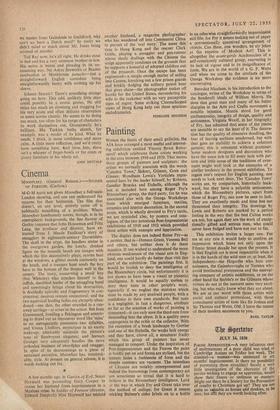Painting
WITHIN the limits of their small galleries, the AIA have arranged a most useful and interest- ing exhibition entitled 'Fitzroy Street Retro- spect' which celebrates those artists working in the area between 1910 and 1920. That means three groups of painters and sculptors : the artists we normally associate with the words 'Camden Town,' Sickert, Gilman, Gore and Ginner; Wyndham Lewis's Vorticists repre- sented here by the leader himself, by Roberts. Gaudier Brzeska and Etchells, although the last is included here among Roger Fry's Bloomsbury group, the third party, for he was associated also with the Omega Workshops from which emerged furniture, textiles, ceramics and interior decoration. In the second room, which is wholly devoted to Fry's circle, we are reminded also, by posters and cata- logues, of the two notorious Post-Impressionist exhibitions of 1910 and 1912 which provided these artists with example and inspiration.
The display does not indeed flatter Fry—as a painter, that is—Duncan Grant, Vanessa Bell and others, but neither does it do there injustice. If one wished to understand the more obvious weaknesses of the visual arts in Eng- land, one could hardly do better than visit this part of the exhibition. The paintings first. It would be foolish to deny the intelligence of the Bloomsbury circle, but unfortunately it is not shown to have been a visual or pictorial intelligence. It would be equally useless to deny their taste in other people's work, especially if we neglect the mistakes which must be made by any unafraid people, with a confidence in their own standards. But taste is a negligible, in fact a dangerous, attribute so far as the creation of works of painting is concerned—it can only save the third-rate from descending into the abyss. It is a quality more appropriate to the critic or the collector. With the exception of a brash landscape by Gertler and one of the Etchells, the works lack energy and they have, above all, a structural frailty which this group of painters has never managed to conquer. Under the inspiration of Post-Impressionism and the Fauves the paint is boldly put on and forms are stylised, but the texture hides a feebleness of form and the simple contours are vacuous. The intentions of Ozanne are notably misrepresented and indeed the borrowings from contemporary art are sometimes so trivial that it is hard to believe in the Bloomsbury intelligence. Look at the way in which Fry and Grant take over the method of collage; for Grant it means sticking Bulmer's cider labels on to a bottle in an otherwise straightforwardly impressionist still life; for Fry it means making out of paper a conventionally conceived arrangement of objects. Can these, one wonders, be sly jokes at the expense of Modern Art? This is altogether the avant-garde Academicism of a self-consciously cultured group, enervating in its lack of vigour and in its insignificance of form. We are in the world of a G. F. Watts and when we come to the artefacts of the Omega Workshop the evidence is no more encouraging.
Benedict Nicolson, in his introduction to the catalogue, writes of the Workshop in terms of the handcraft ideals of William Morris. He does that great man and many of his better disciples in the Arts and Crafts movement a notable injustice. Morris stood for good craftsmanship, integrity of design, quality and seriousness. Virginia Woolf, in her biography of Fry, has admitted that some of the pieces are unstable to say the least of it. The decora- tion has the quality of obsessive doodling, the fear of leaving surfaces unadorned, but with that goes an inability to achieve a coherent pattern; this is ornament without grammar. Some modern designers and decorators who have the same itch to fill every inch with pat- tern and little sense of the traditions of orna- ment might well look at the examples of a similar tendency in the present exhibition. To regain one's respect for English painting, one needs to look next door. The 'Camden Town' works are, by comparison, historically back- ward, but they have a palpable seriousness, which the Bloomsbury pictures, apart from those of Roger Fry, can now be seen to lack. They are excellently made and time has not threatened their integrity. The drawings by Lewis and Roberts are marked by a period feeling in the way that the best Cubist works are not, but again they are the work of excep- tionally gifted and serious men, who could never have fudged and have not nm to fat.
This exhibition invites a larger one. For me at any rate it would help to confirm an impression which bears not only upon the Fitzroy Street decade but upon the present. It is that English art is most respectable when it is in the hands of the wild men or, at least, the independents—the Hogarths who hate con- noisseurs, the Gainsboroughs or Turners who avoid intellectual pretensions and the enervat- ing company of artistic middlemen, or on the other hand the Stubbs's or the Gilmans whose virtues do not at the moment seem very excit- ing, but who really know what they arc about. We are at our worst with those artists with social and cultural pretensions, with those connoisseur artists of taste like Sir Joshua and Sir Thomas and Watts, OM. I leave the names of their modern successors to you.
BASIL TAYLOR


















































 Previous page
Previous page